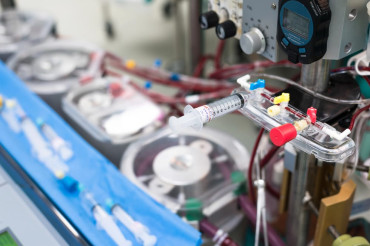Why Is A Heart-Lung Machine Used In Cardiac Surgery?

Hundreds of thousands of cardiac surgeries are performed across the country every year. Many of these procedures are only possible with a heart-lung machine. The heart-lung machine, invented in 1953, has since revolutionized the field of cardiac surgery and continues to make life-saving surgeries possible to this day.
What Is A Heart-Lung Machine?
A heart-lung machine, also called a cardiopulmonary bypass machine, is a piece of equipment that does the work of both the heart (pumping blood) and the lungs (oxygenating the blood). These machines are typically used during major surgeries involving the heart and/or lungs and allow the surgeon to stop a patient’s heart safely without interrupting blood circulation or oxygenation. These machines can also decrease a patient’s body temperature, reducing their body and brain’s need for oxygen.
To use a heart-lung machine, a tube is placed into a central vein in the body to divert blood away from the heart and lungs and into the bypass machine. Once done, the doctor will inject a medication called cardioplegia to stop the heart and a blood thinner to stop blood clots from forming inside the machine. During the procedure, blood is continuously drained into the machine, filtered, cooled, or warmed as needed, and oxygenated before a mechanical pump returns it to the body through a second tube placed into a major artery.
After the surgery is completed and it’s safe to do so, the surgeon will restart the heart. They may do this by flushing the cardioplegia out of the patient’s system, administering a reversing agent, or giving a mild electric shock. Once the heart and lungs are functioning normally, the patient will be slowly weaned off the bypass machine, and all tubes will be removed.
Do All Cardiac Surgeries Require The Use Of A Heart-Lung Machine?
Some minor or superficial cardiac surgeries can be performed on a beating heart using what’s called an “off-pump” technique, where the artificial “pump” of the heart-lung machine is not required. But when the heart needs to be opened to replace a valve, the aorta requires repair, cardiac malformations need to be corrected, or the heart and/or lungs are transplanted, the heart needs to be entirely still for the procedure to be performed safely. In these cases, the heart-lung machine is indispensable.
Are Heart-Lung Machines Safe?
Every medical procedure comes with some risk, and surgeries requiring a heart-lung machine are no different. Known risks include:
- Blood clots.
- Bleeding after surgery.
- Surgical injury to the phrenic nerve (the nerve responsible for breathing).
- Temporary or permanent kidney injury.
- Decreased lung and/or heart function.
Who Operates A Heart-Lung Machine?
Medical technicians, known as perfusionists, operate heart-lung machines. These medical professionals are responsible for setting up, operating, and maintaining the perfusion machine and any associated equipment. They must monitor circulation and ensure the patient’s oxygen level remains stable. They ensure that blood thinners are administered at the proper dosage to keep the blood from clotting in the machine, but not too much that they cause excessive bleeding during or after the procedure. They are also responsible for monitoring and adjusting body temperature as required for the surgery.
A lot can go wrong when a perfusionist is negligent in their duties. If blood flow is interrupted for as little as three to four minutes, particularly if the patient’s body has not been sufficiently cooled, permanent brain damage can occur. In some cases, a negligent perfusionist can even cause a patient’s death.
Why Choose Philadelphia Attorneys At Ross Feller Casey?
Heart-lung machines are indispensable in many cardiac operations. Millions of people are alive today thanks to these machines. But if you or a loved one suffered severe brain damage or death due to the negligent use of a heart-lung machine, you may be entitled to compensation in a medical malpractice lawsuit.
Contact the legal team at Ross Feller Casey for a free consultation. We’ll examine the details of your case, and our on-staff team of Ivy League-trained doctors will determine whether or not your injury was an unavoidable complication of surgery or the result of negligent use of a heart-lung machine. If a perfusionist or surgeon didn’t follow the proper procedures and standards of care in using a heart-lung machine, they should pay for the consequences of their negligent behavior. There’s no fee unless you win, so contact us today.
Disclaimer: Ross Feller Casey, LLP provides legal advice only after an attorney-client relationship is formed. Our website is an introduction to the firm and does not create a relationship between our attorneys and clients. An attorney-client relationship is formed only after a written agreement is signed by the client and the firm. Because every case is unique, the description of awards and summary of cases successfully handled are not intended to imply or guarantee that same success in other cases. Ross Feller Casey, LLP represents catastrophically injured persons and their families in injury and wrongful death cases, providing legal representation in Pennsylvania and New Jersey.





